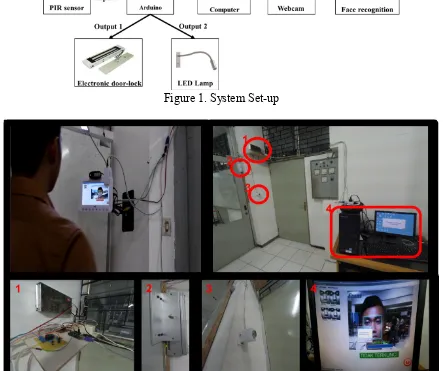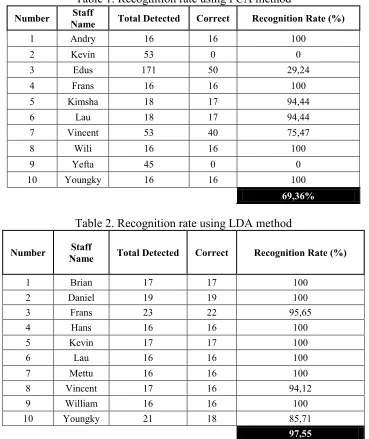Room Access Control System Using Facial Image Recognition
Resmana Lim
1, 2, a, Frans Rotinsuluand
1,band Petrus Santoso
1,c 1Electrical Engineering Dept., Petra Christian University – Indonesia
2
Center of Excellence Geopolymer & Green Technology (CEGeoGTech), School of Materials Engineering, Universiti Malaysia Perlis, Malaysia
a
resmana@petra.ac.id, bm23411016@john.petra.ac.id, cpetrus@petra.ac.id
Keywords: access control, face recognition, home automation, computer vision
Abstract. The aim of the project is to implement a facial recognition system for access control to enter a room. The facial image captured by a webcam and then be detected/tracked using Haar face tracking algorithm. Principal Component Analysis (PCA) and Linear Discriminant Analysis (LDA) algorithm have been used for face recognition. The system was tested with 10 users from the member of a laboratory room. Each user registered 100 images for training of the PCA and LDA. The recognition rate achieved using PCA was 70% and 97% for LDA.
Introduction
Face recognition system has advantages compared with other biometric systems such as using fingerprints/palm and iris, because the process is non-contact. Facial image can be captured from a distance without touching the person being identified, and the identification does not need to interact with the person. In addition, the facial recognition deterrent purpose of the crime because pictures of faces that have been recorded and archived and can help identify a person [1].
PCA and LDA method has been widely used in face recognition and has been implemented in the OpenCV library [2]. In particular the LDA method has been used for student attendance system [3]. The combined method of PCA and LDA can achieve an accuracy of 99% [4].
Our project has been implemented for access control in a laboratory room. Only registered members may access to the room. Training faces with different expressions and poses processed by PCA and LDA to be used to recognized a face input from a webcam.
Methods and System Set-up
Figure 1 shows the system set-up of our room access conrtol based on facial recognition. When the user approaches to the camera, a Pasive Infra Red (PIR) sensor will detect the presence and began to turn on the LED lights. These lights are used to assure that sufficient illumination so that the camera can capture images properly. The software will process the image with face tracking and face image croping to do recognition using PCA and LDA. Only registered members have access entrance into the room. We utilize Open source Computer Vision (OpenCV) library and EmguCV especially in Haar face detection/tracking, and image recognition by PCA and LDA.
Figure 1. System Set-up
Figure 2. System implementation
Haar Face Tracking
We use Haar wavelets which called as Haar-like features [5]. It already implemented on OpenCV library. The Haar detection tracks facial image, and capture face images for recognition purposes. Haar cascade needs to be trained. It needs positive and negative samples. Positive samples are images contain of faces (object of interest) and negative samples are images contain of background, such as wall, floor, etc.
Principal Component Analysis (PCA) [6.7]
A 2D image with dimensions b rows and k columns can be represented in the form of a 1D image with dimensions of n (n = b * k). Training images is used as indicated by {x1,x2,...,xK} consist of the K samples taken from c objects/classes represented by {X1,X2,...,Xc}. Total scatter matrix ST (or covariance matrix) is defined as follows:
K
k
T k k
T x x
S 1
) )(
Where is the average sample image obtained by averaging the image training {x1,x2,...,xK}. With eigen decomposition, this covariance matrix can be decomposed into:
T T
S (2) Where is the eigenvector matrix, and is is a diagonal matrix of eigenvalues. Then select a number of mcolumns of the matrix eigenvector associated with the largest number of m
eigenvalues. This eigenvector election produces a transformation matrix or projection matrix of
m
, which is composed of m column that was chosen eigenvectort that commonly referred to as the 'eigenimage'. Next an image x (with dimension of n) can be extracted into a new feature of y (with dimension m <n) by projecting the x with the direction of m as the following:
ymx (3)
In other words PCA is projecting the space of origin n into a new lower space dimension of m
, where as much as possible the original information content will be retained for not too much disappeared after being taken to a smaller feature dimensions [8,9]. Here we can see a significant reduction feature of n into m pieces which will greatly ease the computing of the recognition process in the next phase.
Total scatter matrix ST above is actually the sum of a within-class scatter matrix SW and the
inter-class scatter matrix (between-class scatter matrix) SB, ie, ST SW SB. Thus, the major drawback seen here is that in the process of PCA, the two scatter matrix are maximized together. Indeed desired is only maximization of SB alone, whereas minimized SW as much as possible so that members distribution can be collected in the class, which in turn can increase the success rate of the recognition. Suppose that the variation of illumination change and the scale of the image that occurs on the same object, can cause matrix becomes large scatter in the classroom is quite difficult in the recognition process. When this occurs, thereby PCA will include a variety of illumination in its eigenimage, and consequently PCA be reliable enough against illumination variations that occur in the object. With the LDA method, SW will be minimized so that the resulting feature extraction becomes more reliable against variations that occur in the class [10].
Linear Discriminant Analysis (LDA)
minimized while inter-class scatter matrix SB is maximized. In other words, the projection matrix
l
will be sought so that the ratio equation (6) becomes maximal.
)
These criteria resulted in a solution with the following equation [3]:
W
B S
Where is the eigenvector matrix, and is the diagonal matrix of eigenvalues. In other words to be searched eigenvector and eigenvalue of the matrix C which is a combination within and between class scatter matrix as in eq. 8. Again, the election of as many as l columns of the eigenvector associated with the largest eigenvalues. Selection of column eigenvector l produces a projection matrix l that is subsequently used for feature extraction as well as on the PCA [4,10].
1
SbSw
C (8)
Results and Discussion
The system was tested with the users of 10 (c=10) laboratory staffs who are allowed to access the room. Each staff has 100 images with different poses and expressions, so the total we have K of 1000 sample/training images (K=10x100=1000). Each image was in grayscale with the size of 100x100 pixels. These images have been used as training images for PCA (with the size of feature m =80 components) and LDA.
Table 1. Recognition rate using PCA method
Number Staff
Name Total Detected Correct Recognition Rate (%)
1 Andry 16 16 100
2 Kevin 53 0 0
3 Edus 171 50 29,24
4 Frans 16 16 100
5 Kimsha 18 17 94,44
6 Lau 18 17 94,44
7 Vincent 53 40 75,47
8 Wili 16 16 100
9 Yefta 45 0 0
10 Youngky 16 16 100
69,36%
Table 2. Recognition rate using LDA method
Number Staff
Name Total Detected Correct Recognition Rate (%)
1 Brian 17 17 100
2 Daniel 19 19 100
3 Frans 23 22 95,65
4 Hans 16 16 100
5 Kevin 17 17 100
6 Lau 16 16 100
7 Mettu 16 16 100
8 Vincent 17 16 94,12
9 William 16 16 100
10 Youngky 21 18 85,71
97,55
Conclusion
The access control system based on face recognition has been implemented. The accuracy of the recognition using PCA was 70% and 97% for LDA. From the experimental results, in general, when a variety of training images is high enough (eg: illumination, expression and pose) then the use of LDA will contribute higher recognition rate. Even with a smaller number of features, LDA gives better results when in comparison with the use of PCA.
References
[1] A. K. Jain, A. Ross, and S. Prabhakar: An introduction to biometric recognition, Circuits and Systems for Video Technology, IEEE Transactions on 14(1), (2004) p. 4-20.
[2] A. C. Bhensle and R. Raja, An efficient face recognition using PCA and Euclidean distance classification. International Journal of Computer Science and Mobile Computing, 3(6), (2014) p. 407–413.
[3] W. Budhiharto, The access control system based on linear discriminant analysis. Journal of Computer Science, 10(3), (2014) p. 453–457. doi:10.3844/jcssp.2014.453.457
[4] S. Singh, M. Sharma and S. Rao, Accurate face recognition using PCA and LDA. International Journal of Computer Science and Information Security, 10(3), (2012) p. 103–112.
[5] J. Cho, S. Mirzaei, J. Oberg and R. Kastner, in: FPGA-Based face detection system using Haar classifiers ,Proceedings of the ACM/SIGDA international symposium on Field programmable gate arrays. ACM, (2009)
[6] M. P. Shermi and A. M. Ali (2012). A principal component analysis method for recognition of human faces: Eigenfaces approach. International Journal of Electronics Communication and Computer Technology (IJECCT), 2(3), p. 139–144.
[7] L. C. Paul, and A. A. Sumam, Face recognition using principal component analysis method.
International Journal of Advanced Research in Computer Engineering & Technology (IJARCET), 1(9), (2012) p. 135–139.
[8] C. Johnson, EMGU Multiple Face Recognition using PCA and Parallel Optimisation -
CodeProject. Retrieved May 13, 2015, from
http://www.codeproject.com/Articles/261550/EMGU-Multiple-Face-Recognition-using-PCA-a nd-Paral
[9] Liliana, R. Lim, and E. Kwan, in: Voice conversion application (VOCAL). Uncertainty Reasoning and Knowledge Engineering (URKE), International Conference on. Vol. 1. IEEE, (2011).

